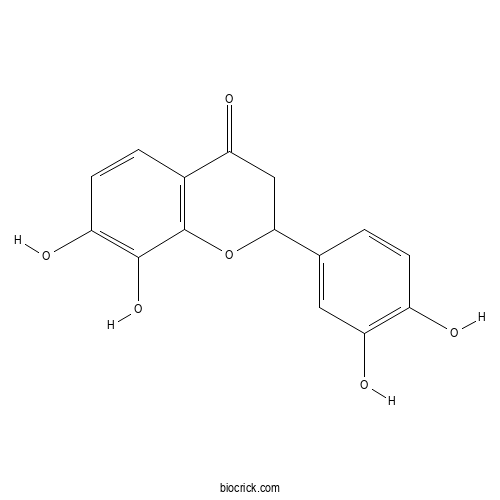7,8,3',4'-TetrahydroxyflavanoneCAS# 489-73-6 |

- Isookanin
Catalog No.:BCN6476
CAS No.:1036-49-3
Quality Control & MSDS
3D structure
Package In Stock
Number of papers citing our products

| Cas No. | 489-73-6 | SDF | Download SDF |
| PubChem ID | 12309904.0 | Appearance | Powder |
| Formula | C15H12O6 | M.Wt | 288.25 |
| Type of Compound | Dihydroflavones | Storage | Desiccate at -20°C |
| Solubility | Soluble in Chloroform,Dichloromethane,Ethyl Acetate,DMSO,Acetone,etc. | ||
| Chemical Name | 2-(3,4-dihydroxyphenyl)-7,8-dihydroxy-2,3-dihydrochromen-4-one | ||
| SMILES | C1C(OC2=C(C1=O)C=CC(=C2O)O)C3=CC(=C(C=C3)O)O | ||
| Standard InChIKey | ZPVNWCMRCGXRJD-UHFFFAOYSA-N | ||
| Standard InChI | InChI=1S/C15H12O6/c16-9-3-1-7(5-12(9)19)13-6-11(18)8-2-4-10(17)14(20)15(8)21-13/h1-5,13,16-17,19-20H,6H2 | ||
| General tips | For obtaining a higher solubility , please warm the tube at 37 ℃ and shake it in the ultrasonic bath for a while.Stock solution can be stored below -20℃ for several months. We recommend that you prepare and use the solution on the same day. However, if the test schedule requires, the stock solutions can be prepared in advance, and the stock solution must be sealed and stored below -20℃. In general, the stock solution can be kept for several months. Before use, we recommend that you leave the vial at room temperature for at least an hour before opening it. |
||
| About Packaging | 1. The packaging of the product may be reversed during transportation, cause the high purity compounds to adhere to the neck or cap of the vial.Take the vail out of its packaging and shake gently until the compounds fall to the bottom of the vial. 2. For liquid products, please centrifuge at 500xg to gather the liquid to the bottom of the vial. 3. Try to avoid loss or contamination during the experiment. |
||
| Shipping Condition | Packaging according to customer requirements(5mg, 10mg, 20mg and more). Ship via FedEx, DHL, UPS, EMS or other couriers with RT, or blue ice upon request. | ||

7,8,3',4'-Tetrahydroxyflavanone Dilution Calculator

7,8,3',4'-Tetrahydroxyflavanone Molarity Calculator
| 1 mg | 5 mg | 10 mg | 20 mg | 25 mg | |
| 1 mM | 3.4692 mL | 17.3461 mL | 34.6921 mL | 69.3842 mL | 86.7303 mL |
| 5 mM | 0.6938 mL | 3.4692 mL | 6.9384 mL | 13.8768 mL | 17.3461 mL |
| 10 mM | 0.3469 mL | 1.7346 mL | 3.4692 mL | 6.9384 mL | 8.673 mL |
| 50 mM | 0.0694 mL | 0.3469 mL | 0.6938 mL | 1.3877 mL | 1.7346 mL |
| 100 mM | 0.0347 mL | 0.1735 mL | 0.3469 mL | 0.6938 mL | 0.8673 mL |
| * Note: If you are in the process of experiment, it's necessary to make the dilution ratios of the samples. The dilution data above is only for reference. Normally, it's can get a better solubility within lower of Concentrations. | |||||

Calcutta University

University of Minnesota

University of Maryland School of Medicine

University of Illinois at Chicago

The Ohio State University

University of Zurich

Harvard University

Colorado State University

Auburn University

Yale University

Worcester Polytechnic Institute

Washington State University

Stanford University

University of Leipzig

Universidade da Beira Interior

The Institute of Cancer Research

Heidelberg University

University of Amsterdam

University of Auckland

TsingHua University

The University of Michigan

Miami University

DRURY University

Jilin University

Fudan University

Wuhan University

Sun Yat-sen University

Universite de Paris

Deemed University

Auckland University

The University of Tokyo

Korea University
- Sinocrassoside C1
Catalog No.:BCX1219
CAS No.:909803-26-5
- Panaxcerol C
Catalog No.:BCX1218
CAS No.:63180-02-9
- Linocinnamarin
Catalog No.:BCX1217
CAS No.:554-87-0
- α-D-altro-3-Heptulofuranose
Catalog No.:BCX1216
CAS No.:25545-06-6
- Dihydrooroxylin A-7-O-β-D-glucuronide
Catalog No.:BCX1215
CAS No.:1370002-08-6
- Hydroxy-ε-sanshool
Catalog No.:BCX1214
CAS No.:252193-26-3
- Ethyl linoleate
Catalog No.:BCX1213
CAS No.:544-35-4
- 6''-Acetylhyperin
Catalog No.:BCX1212
CAS No.:72659-75-7
- Ergosterol Acetate
Catalog No.:BCX1211
CAS No.:2418-45-3
- N-Deacetyllappaconitine
Catalog No.:BCX1210
CAS No.:11033-64-0
- Ergosta-7,22,24(28)-trien-3β-ol
Catalog No.:BCX1209
CAS No.:36680-39-4
- Rhamnetin-3-O-β-D-Glucoside
Catalog No.:BCX1208
CAS No.:27875-34-9
- 7'R,8'R-2,2'-Dimethoxy-4-(3-hydroxyl-propenyl)-4'-(1,2,3-trihydroxy-propyl) biphenyl ether
Catalog No.:BCX1221
CAS No.:515813-60-2
- 7,3',5'-Trihydroxyflavanone
Catalog No.:BCX1222
CAS No.:847375-46-6
- 5,7-Dihydroxychroman-4-one
Catalog No.:BCX1223
CAS No.:108085-46-7
- threo-guaiacylglycerol-β-O-4'-sinapyl ether
Catalog No.:BCX1224
CAS No.:288864-26-6
- Erythro-guaiacylglycerol-β-O-4'-sinapyl ether
Catalog No.:BCX1225
CAS No.:905726-70-7
- Cnidimol B
Catalog No.:BCX1226
CAS No.:103629-81-8
- β-Obscurin
Catalog No.:BCX1227
CAS No.:467-79-8
- Argentinogenin
Catalog No.:BCX1228
CAS No.:4236-48-0
- 2,7-dihydroxy-4, 6-dimethoxy phenanthrene
Catalog No.:BCX1229
CAS No.:108352-70-1
- Segetalin C
Catalog No.:BCX1230
CAS No.:177602-12-9
- Dihydrobaicalin
Catalog No.:BCX1231
CAS No.:56226-98-3
- Isocoreopsin
Catalog No.:BCX1232
CAS No.:30382-18-4
Characteristic flavonoids from Acacia burkittii and A. acuminata heartwoods and their differential cytotoxicity to normal and leukemia cells.[Pubmed:19370878]
Nat Prod Commun. 2009 Jan;4(1):69-76.
Bioassay-guided fractionation of extracts from Acacia burkittii and A. acuminata heartwoods against an L1210 (mouse lymphoma) cell line led to the isolation of two flavan-3,4-diols, melacacidin (1) and isomelacacidin (2), and three flavonoids, 3,7,8,3',4'-pentahydroxyflavone (3), 7,8,3',4'-tetrahydroxyflavanone (4) and 3,7,8,3',4'-pentahydroxyflavanone (5). HPLC analyses (280 nm) of the 70% acetone extracts of the two plants showed different profiles in terms of the relative concentration of the five identified compounds. When tested against L1210, compounds 1 and 2 were the most active, giving ID50 values of 2.5 and 4.5 microg/mL, respectively. The lower activity of the other isolated compounds indicated the importance of the 3,4-hydroxyl groups for the cytotoxic activity of these flavonoids. The isolated compounds were either non-toxic or had very low toxicities against the "normal" CV-1 cell line (green monkey kidney cells). The O-methyl and O-acetyl derivatives of these compounds were inactive. Ten commercially available phenolic compounds (6-15) were also tested for their activity against both CV-1 and L1210 cell lines. Flavan-3,4-diols 1 and 2 were more cytotoxic to L1210 cells than all tested compounds, including catechin and epicatechin, the most abundant flavan-3-ols in many fruits and vegetable.


